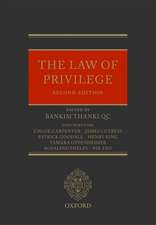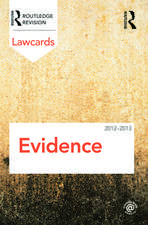Regulating Dispute Resolution: ADR and Access to Justice at the Crossroads
Editat de Felix Steffek, Hannes Unberath Hazel Genn, Professor Dr Reinhard Greger, Carrie Menkel-Meadowen Limba Engleză Hardback – 24 sep 2013
Preț: 577.76 lei
Preț vechi: 821.21 lei
-30% Nou
Puncte Express: 867
Preț estimativ în valută:
110.55€ • 116.04$ • 91.76£
110.55€ • 116.04$ • 91.76£
Carte tipărită la comandă
Livrare economică 10-24 aprilie
Preluare comenzi: 021 569.72.76
Specificații
ISBN-13: 9781849462587
ISBN-10: 1849462585
Pagini: 490
Dimensiuni: 171 x 244 x 35 mm
Greutate: 1 kg
Ediția:New.
Editura: Bloomsbury Publishing
Colecția Hart Publishing
Locul publicării:London, United Kingdom
ISBN-10: 1849462585
Pagini: 490
Dimensiuni: 171 x 244 x 35 mm
Greutate: 1 kg
Ediția:New.
Editura: Bloomsbury Publishing
Colecția Hart Publishing
Locul publicării:London, United Kingdom
Caracteristici
This book sets out a principled and comprehensive approach to the regulation of the dispute resolution mechanisms.Throughout the book examples and analysis are taken from the theory and practice of dispute resolution in Austria, Belgium, Denmark, England, France, Germany, Italy, Japan, the Netherlands, Norway, Switzerland and the USA. The authors then propose a set of regulatory principles based on ethical guidelines and efficiency considerations.The book will be of interest to anyone concerned with alternative dispute resolution.
Notă biografică
Felix Steffek, Senior Research Fellow at the Max Planck Institute for Comparative and International Private Law, Hamburg.Hannes Unberath, Professor of Law at the University of Bayreuth (deceased).Hazel Genn DBE, KC (Hon), Dean of Laws, University College London.Reinhard Greger, Professor of Law at the University of Erlangen-Nürnberg.Carrie Menkel-Meadow, Professor of Law at UC Irvine School of Law and Professor of Dispute Resolution and Civil Procedure at Georgetown University Law School.
Cuprins
Part 1: Fundamental Issues 1 Guide for Regulating Dispute Resolution (GRDR): Principles Felix Steffek and Hannes Unberath (coordinators), Lin Adrian, Aldo De Matteis, Giuseppe De Palo, Frédérique Ferrand, Reinhard Greger, Jana Härtling, Ulrike Janzen, Shusuke Kakiuchi, Lars Kirchhoff , Peter G Mayr, Isaak Meier, Kristin Nemeth, Machteld Pel, Anneken K Sperr and Ivan Verougstraete2 Guide for Regulating Dispute Resolution (GRDR): Principles and Comments Felix Steff ek and Hannes Unberath (coordinators), Lin Adrian, Aldo De Matteis, Giuseppe De Palo, Frédérique Ferrand, Reinhard Greger, Jana Härtling, Ulrike Janzen, Shusuke Kakiuchi, Lars Kirchhoff , Peter G Mayr, Isaak Meier, Kristin Nemeth, Machteld Pel, Anneken K Sperr and Ivan Verougstraete3 Principled Regulation of Dispute Resolution: Taxonomy, Policy, Topics Felix SteffekPart 2: Regulation of Dispute Resolution 4 Regulation of Dispute Resolution in Austria: A Traditional Litigation Culture Slowly Embraces ADR Peter G Mayr and Kristin Nemeth5 Regulation of Dispute Resolution in Belgium: Workable Solutions? Ivan Verougstraete6 Regulation of Dispute Resolution in Denmark: Mediation, Arbitration, Boards and Tribunals Lin Adrian7 Regulation of Dispute Resolution in England and Wales: A Sceptical Analysis of Government and Judicial Promotion of Private Mediation Hazel Genn, Shiva Riahi and Katherine Pleming8 Regulation of Dispute Resolution in France: Evolutions and Challenges Frédérique Ferrand9 Regulation of Dispute Resolution in Germany: Cautious Steps towards the Construction of an ADR System Burkhard Hess and Nils Pelzer10 Regulation of Dispute Resolution in Italy: The Bumps in the Road to Successful ADR Giuseppe De Palo and Ashley E Oleson11 Regulation of Dispute Resolution in Japan: Alternative Dispute Resolution and its Background Shusuke Kakiuchi12 Regulation of Dispute Resolution in the Netherlands: Does Regulation Support or Hinder the Use of ADR? Machteld Pel13 Regulation of Dispute Resolution in Norway: Vertical and Horizontal Regulatory Strategies Anneken Kari Sperr14 Regulation of Dispute Resolution in Switzerland: Mediation, Conciliation and Other Forms of ADR in Switzerland Isaak Meier in cooperation with Miguel Sogo, Sotirios Kotronis, Sarah Scheiwiller, David Siegwart, Claudia Wyss, Dheden Zotsang and Carlo Hamburger15 Regulation of Dispute Resolution in the United States of America: From the Formal to the Informal to the 'Semi-formal' Carrie Menkel-Meadow
Recenzii
A valuable tool for a common approach in dispute resolution policies within the EU. A useful guide on CDR systems in various non-EU countries.
When it comes to dispute resolution one of the major issues at hand is the handling of transnational disputes and the author provides a guide for regulation in this area. The extensive research conducted by the author is evident as he incorporates a wealth of Dispute resolution knowledge from about 12 jurisdictions.The publication as a whole can be described as an extremely handy one and would merit close and thoughtful reading by any audience in the field of dispute resolution.
This special approach to the field of dispute resolution, tackled by renowned experts with a background in academia, practice and legislating will certainly make this work a reference book on ADR in the coming years.
Although many readers might assume that the book will be relevant only for those with an interest or practice in international dispute resolution, American practitioners and policy makers can just as easily use the book's comparative approach to compare and contrast domestic dispute resolution systems and regulation. There are tremendous differences in the use and regulation of ADR from state to state within the United States and even from county to county within a single state. A comparative analysis, like the one undertaken in this book, permits practitioners and policy makers to decide whether such variation is most beneficial to the parties using dispute resolution - or whether some degree of harmonization might be in order.a useful, comprehensive, and thought-provoking book.
The analysis and discussion of the principles and functions of ADR will be of great interest and even benefit to all those concerned about its future development whether in government, the judiciary or any of the multitude of service providers as well as any practising mediator (or other ADR practitioner) who cares about the future of his or her profession.
...the authors accomplish a commendable feat by effectively capturing and transposing the essence of every dispute resolution mechanism through the perspective of a functional taxonomy, while leaving an open normative framework that allows for regional and local adaptations, all of which is presented in a modular, highly flexible structure of regulatory topics.this book offers a wealth of information and ideas useful not only for legislators in their quest of delivering justice through the regulation of the legal system, but also for all policy-makers, professional associations, practitioners and academics in thinking about the best ways to contribute to this noble goal.
Overall, the book is very ambitious and distinctive in its offering of a taxonomy to inform principled regulation across jurisdictions. It has successfully provided a refreshingly new lens to view the very important issues of regulating dispute resolution that have a substantive impact.
When it comes to dispute resolution one of the major issues at hand is the handling of transnational disputes and the author provides a guide for regulation in this area. The extensive research conducted by the author is evident as he incorporates a wealth of Dispute resolution knowledge from about 12 jurisdictions.The publication as a whole can be described as an extremely handy one and would merit close and thoughtful reading by any audience in the field of dispute resolution.
This special approach to the field of dispute resolution, tackled by renowned experts with a background in academia, practice and legislating will certainly make this work a reference book on ADR in the coming years.
Although many readers might assume that the book will be relevant only for those with an interest or practice in international dispute resolution, American practitioners and policy makers can just as easily use the book's comparative approach to compare and contrast domestic dispute resolution systems and regulation. There are tremendous differences in the use and regulation of ADR from state to state within the United States and even from county to county within a single state. A comparative analysis, like the one undertaken in this book, permits practitioners and policy makers to decide whether such variation is most beneficial to the parties using dispute resolution - or whether some degree of harmonization might be in order.a useful, comprehensive, and thought-provoking book.
The analysis and discussion of the principles and functions of ADR will be of great interest and even benefit to all those concerned about its future development whether in government, the judiciary or any of the multitude of service providers as well as any practising mediator (or other ADR practitioner) who cares about the future of his or her profession.
...the authors accomplish a commendable feat by effectively capturing and transposing the essence of every dispute resolution mechanism through the perspective of a functional taxonomy, while leaving an open normative framework that allows for regional and local adaptations, all of which is presented in a modular, highly flexible structure of regulatory topics.this book offers a wealth of information and ideas useful not only for legislators in their quest of delivering justice through the regulation of the legal system, but also for all policy-makers, professional associations, practitioners and academics in thinking about the best ways to contribute to this noble goal.
Overall, the book is very ambitious and distinctive in its offering of a taxonomy to inform principled regulation across jurisdictions. It has successfully provided a refreshingly new lens to view the very important issues of regulating dispute resolution that have a substantive impact.
Descriere
This book sets out a principled and comprehensive approach to the regulation of the dispute resolution mechanisms in all their varieties. Examples and analysis are taken from a wide number of countries in Europe, Scandinavia, Japan and the USA.














